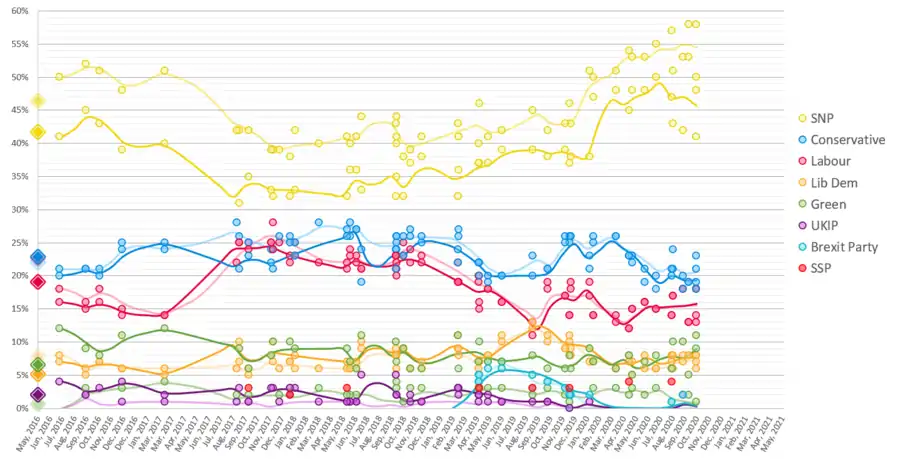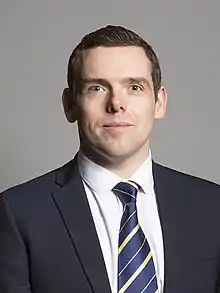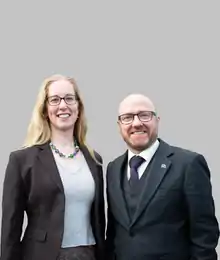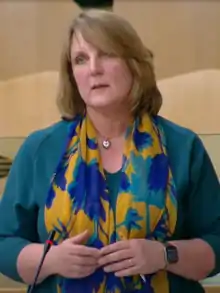2021 Scottish Parliament election
The next Scottish Parliament election is scheduled to be held on 6 May 2021[3] under the Scotland Act 1998, although this does not preclude the Parliament being dissolved earlier. 129 Members of the Scottish Parliament will be elected in the sixth election since the parliament was reestablished in 1999.
| |||||||||||||||||||||||||||||||||||||||||||||||||||||||||||||||||||||
All 129 seats to the Scottish Parliament 65 seats needed for a majority | |||||||||||||||||||||||||||||||||||||||||||||||||||||||||||||||||||||
|---|---|---|---|---|---|---|---|---|---|---|---|---|---|---|---|---|---|---|---|---|---|---|---|---|---|---|---|---|---|---|---|---|---|---|---|---|---|---|---|---|---|---|---|---|---|---|---|---|---|---|---|---|---|---|---|---|---|---|---|---|---|---|---|---|---|---|---|---|---|
| Opinion polls | |||||||||||||||||||||||||||||||||||||||||||||||||||||||||||||||||||||
| |||||||||||||||||||||||||||||||||||||||||||||||||||||||||||||||||||||
| |||||||||||||||||||||||||||||||||||||||||||||||||||||||||||||||||||||
Background
Electoral events
- 2016 Scottish Parliament election
At the 2016 election, the ruling Scottish National Party (SNP) lost their parliamentary majority but were able to continuing governing under Nicola Sturgeon as a minority government.[4] At the same election, the Conservatives overtook Labour into second place, whilst the Greens overtook the Liberal Democrats into fourth place.[4] No representatives of minor parties were elected to the Parliament.[4]
- 2017 local elections
The 2017 local elections saw the SNP hold their first preference vote share compared to 2012 at 32%, finishing as the largest party in half of councils (sixteen).[5]
The Conservatives considerably increased their vote share to 25%, an increase of 12%, as they became the largest party outright in six council areas and joint largest in another.[5] Labour fell 11% to 20% and became the largest party outright in only three councils, compared to fifteen in 2012.[5]
Independent candidates won 10% of the vote, down 1%, as the Lib Dems were marginally up, winning 7% of votes. The Greens increased their share by 2%, to earn 4% of votes.[5] For the first time since the move to STV voting in local government, no mainland council had a majority government.[5]
- 2017 United Kingdom general election
A month after, at 2017 UK election, the SNP lost twenty-one of their MPs, winning thirty-five seats on 37% of the vote (down thirteen percentage points). Most notably, former-First Minister Alex Salmond and Angus Robertson, the party's Westminster leader, lost their seats.[6]
The Conservatives won their highest vote share in any election in Scotland since 1979, at 29%, and their highest number of MPs since 1983, winning thirteen.[6] They surpassed Labour on both accounts, with Labour earning 28% and seven seats - both an improvement over their 2015 showing. The Lib Dems won four seats, up three, but lost nearly 1% of their national vote share. None of the smaller parties managed more than 0.2% of the vote. UKIP and the Greens heavily reduced the number of candidates compared to 2015, with UKIP down from forty-one to ten and the Greens from thirty-one to three.[6]
- 2019 European Parliament election
The 2019 European election was dominated by the impending Brexit-deadline and was won in Scotland by the SNP. The party won three of the six seats, up one from 2014, in the European Parliament and increased their vote share from 29% to 38%; they were the largest party in all local authority areas, with the exception of Orkney and Shetland.[7]
The Brexit Party, led by former-UKIP leader Nigel Farage, finished second on 15% - 4% higher than UKIP achieved in 2014. The pro-remain Liberal Democrats won 14% of the vote and were the largest party in the two Northern Isle councils.[7]
Both the Conservatives and Labour performed badly across Britain, and finished fourth and fifth in Scotland respectively. The Tories fared relatively better in Scotland than elsewhere in the UK, achieving 12% (down 6% on 2014) in Scotland compared to 9% elsewhere. Labour lost 17% of the vote, finishing on 9%, and had their worst showing in Scotland since 1910; the Greens held level at 8%.[7]
The Brexit Party, Lib Dems and Conservatives each won a single seat, in addition to the SNP's three. Labour (two) and UKIP (one) lost the seats they won in 2014.[7]
- 2019 United Kingdom general election
The SNP increased their vote share to 45% at the 2019 general election, only 5% behind their 2015 performance, reclaiming thirteen of the seats they lost in 2017.[8]
The Conservatives lost half the seats they gained in 2017, but retained a quarter of the vote - down 4%. The party won a majority of seats in the House of Commons across the UK; their biggest majority since 1987. Labour recorded their worst general election result in Scotland since 1910, as they were reduced to a single Scottish seat again and achieved a 19% share of the vote. Across Britain, the party suffered its worst result since 1935, with many former safe Labour seats being gained by the Conservatives.[8][9]
The Liberal Democrats made no net losses, but Jo Swinson, the party's UK leader, lost her seat to the SNP. The party increased their share by 3%, to record just under one in ten votes.[10] The Greens managed 1% of the vote, as they stood in twenty-two seats.[8]
Leadership changes
Three parties have undergone leadership changes during the parliamentary term. In 2017 Kezia Dugdale resigned as Leader of Scottish Labour and was replaced by Richard Leonard.[11] On 14 January 2021 Leonard resigned less than 4 months before the election is currently scheduled to be held.[12] The 2021 Scottish Labour leadership election was held in February 2021.
On 1 August 2019, Lorna Slater became co-leader of the Scottish Greens alongside Patrick Harvie.
Later in August 2019, Ruth Davidson resigned as leader of the Scottish Conservatives and was succeeded by Jackson Carlaw.[13] Carlaw, however, would himself resign from the leadership in July 2020.[14] Douglas Ross won the subsequent leadership election without opposition.[15]
Expansion of the electorate
This is the first election after the passage of the Scottish Elections (Franchise and Representation) Act, which extended the franchise to those serving prison sentences of 12 months or less.[16][17] In 2005, the United Kingdom was found in breach of Protocol 1, Article 3 of the European Convention on Human Rights in regards of prisoner voting rights in the European Court of Human Rights as a result of Hirst v United Kingdom (No 2); the Act brings Scotland inline with the court ruling.[18]
This act also allows all foreign nationals resident in Scotland to vote and all those with indefinite leave to remain or equivalent status including pre–settled status in the United Kingdom to stand as candidates.[19][16]
Date
Under the Scotland Act 1998, an ordinary general election to the Scottish Parliament would normally have been held on the first Thursday in May four years after the 2016 election, i.e. in May 2020.[20] This would have clashed with the proposed date of a UK general election, although this became a moot point when a snap UK general election was held in June 2017 (a further UK general election was held in December 2019).[21] In November 2015, the Scottish Government published a Scottish Elections (Dates) Bill, which proposed to extend the term of the Parliament to five years.[21] That Bill was passed by the Scottish Parliament on 25 February 2016 and received Royal Assent on 30 March 2016, setting the new date for the election as 6 May 2021.[3]
The Scottish Elections (Dates) Act does not affect the legal possibilities for the Parliament to be dissolved earlier, those being;
- That the date of the poll may be varied by up to one month either way by the monarch, on the proposal of the Presiding Officer.[20]
- If Parliament itself resolves that it should be dissolved, with at least two-thirds of the Members (i.e. 86 Members) voting in favour, the Presiding Officer proposes a date for an extraordinary general election and the Parliament is dissolved by the monarch by royal proclamation.[22]
- If Parliament fails to nominate one of its members to be First Minister within 28 days, irrespective of whether at the beginning or in the middle of a parliamentary term.[22] Therefore, if the First Minister resigned, Parliament would then have 28 days to elect a successor and if no new First Minister was elected then the Presiding Officer would ask for Parliament to be dissolved. This process could also be triggered if the First Minister lost a vote of confidence by a simple majority, as they must then resign. To date the Parliament has never held a confidence vote on a First Minister.
Nevertheless, no extraordinary general elections have been held to date. Any extraordinary general elections would be in addition to ordinary general elections, unless held less than six months before the due date of an ordinary general election, in which case they supplant it.[22] However, this would not affect the year in which the subsequent ordinary general election will be held.[22]
On 16 November 2020, the Scottish General Election (Coronavirus) Bill was introduced.[23] This draft legislation stated that while the next election is intended to be held on 6 May 2021, powers would be given to the Presiding Officer to postpone the election by up to six months if the spread of COVID-19 made that date impractical.[23]
Retiring MSPs
James Dornan announced in February 2020 his intention to retire at the next Holyrood election,[52] but reversed this decision some months later.[53]
Parties
| Name | Ideology | Leader(s) | 2016 result | Current seats | |||
|---|---|---|---|---|---|---|---|
| Votes (%) | Seats | ||||||
| Regional | Constituency | ||||||
| Scottish National Party | Scottish nationalism Scottish independence Social democracy |
Nicola Sturgeon MSP for Glasgow Southside |
41.7% | 46.5% | 63 / 129 |
61 / 129 | |
| Scottish Conservatives | Conservatism British unionism |
Douglas Ross Not an MSP |
22.9% | 22.0% | 31 / 129 |
30 / 129 | |
| Scottish Labour | Social democracy British unionism Democratic socialism |
Vacant Since 14 January 2021 |
19.1% | 22.6% | 24 / 129 |
23 / 129 | |
| Scottish Greens | Green politics Scottish independence Scottish republicanism |
Patrick Harvie (co-leader) MSP for Glasgow |
6.6% | 0.6% | 6 / 129 |
5 / 129 | |
| Lorna Slater (co-leader) Not an MSP | |||||||
| Scottish Liberal Democrats | Liberalism British unionism Federalism |
Willie Rennie MSP for North East Fife |
5.2% | 7.8% | 5 / 129 |
5 / 129 | |
| Reform UK | Populism Euroscepticism |
Michelle Ballantyne MSP for South Scotland |
– | – | 0 / 129 |
1 / 129 | |
| Presiding Officer | – | – | – | – | 0 / 129 |
1 / 129 | |
The three remaining seats are occupied by independents.
Election system, seats, and regions
The total number of Members of the Scottish Parliament (MSPs) elected to the Parliament is 129.
The Scottish Parliament uses an Additional Members System, designed to produce approximate proportional representation for each region. There are 8 regions, each sub-divided into smaller constituencies. There are a total of 73 constituencies. Each constituency elects one MSP by the plurality (first past the post) system of election. Each region elects 7 additional MSPs using an additional member system. A modified D'Hondt method, using the constituency results, is used to elect these additional MSPs.[54][55]
The boundaries of the 73 constituencies last changed as of the 2011 Scottish Parliament election, as did the configuration of the electoral regions used to elect "list" members of the Scottish Parliament,.[56] These revisions were the outcome of the First Periodical Review of the Scottish Parliament's constituencies and regions conducted by the Boundary Commission for Scotland; the Review was announced on 3 July 2007 and the Commission published its final report on 26 May 2010.
The Scottish Parliament constituencies have not been coterminous with Scottish Westminster constituencies since the 2005 general election, when the 72 former UK Parliament constituencies were replaced with a new set of 59, generally larger, constituencies (see Scottish Parliament (Constituencies) Act 2004). The size difference between Westminster and Holyrood boundaries was due to diverge further upon the implementation of the Sixth Periodic Review of Westminster constituencies, which has not been voted upon by Parliament. The 2023 Periodic Review of Westminster constituencies for a UK total of 650 MPs will commence in 2021.
Candidates
Former Westminster MP Alan Reid is the lead list candidate for the Scottish Liberal Democrats in the Highlands and Islands electoral region.[57] Alliance 4 Unity, a new alliance party set up by George Galloway, will field candidates as well.[58]
Monica Lennon is standing for Labour in Hamilton, Larkhall and Stonehouse.[59]
Opinion polling
The chart shows the relative state of the parties since polling began from the last election. The constituency vote is shown as semi-transparent lines, while the regional vote is shown in full lines.

The SSP abbreviation on the graph refers to the Scottish Socialist Party. The party gained its first seat in the Scottish Parliament in 1999 and held six seats from 2003–2007. In the 2016 Scottish Parliament election it contested as part of RISE – Scotland's Left Alliance, but failed to gain any seats. The SSP continues to be included in some opinion polls.
Target seats
Below are listed all the constituencies which require a swing of less than 5% from the 2016 result to change hands. The Greens require a 7.1% swing to gain Glasgow Kelvin and the Liberal Democrats require a 6.1% swing to gain Caithness, Sutherland and Ross. In both cases these are the most marginal opportunities for these parties.
.jpg.webp)



.png.webp)
